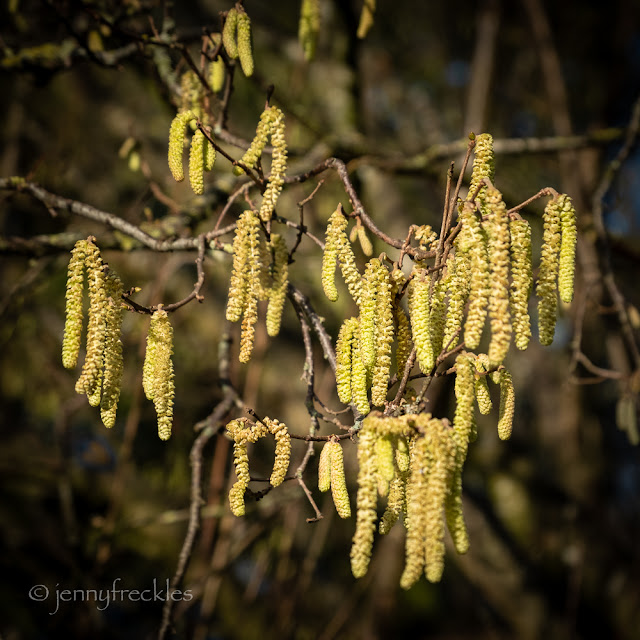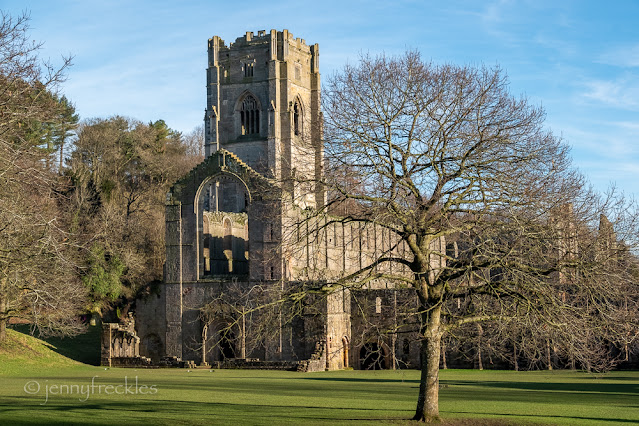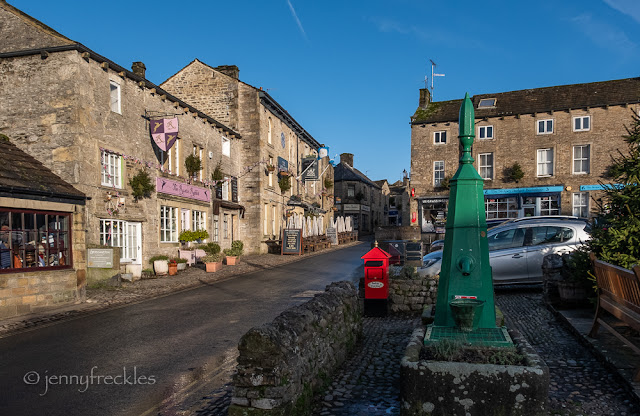Well, the green, green grass not far from home, at any rate. I took these photos on a ramble with a friend around the village of Burley in Wharfedale. They're not particularly special or outstanding in any way - just ordinary views such as you can find all around here: semi-rural, with ribbons of residential development along the main roads and lots of fields, woods and moorland to explore if you know the right pathways to take, beloved of dog-walkers and runners. (We passed - or were passed by - lots of both!) We wander among sheep and a few cattle - and those ever-present Yorkshire drystone walls. The hill on the left is in fact the long ridge on the south side of the valley, called Otley Chevin. (Did a walk around there last year - HERE). On a clear day you can, apparently, see as far as York Minster from here but as you can see it wasn't a clear day at all - rather murky in fact. We still enjoyed our walk and I feel fortunate to be able to explore our countryside and our public footpaths freely, whenever I want to.
Monday 31 January 2022
Sunday 30 January 2022
January nature notes
January has been relatively mild and damp, ideal conditions for making nature think Spring is already here... Here is a random selection of things that have caught my eye this month.
Waxy hellebores in a churchyard...
A curious swan that swam over to see if I was carrying food...
Teasel seedheads silhouetted against a wintry sky...
A few early snowdrops coming into bloom...
Hazel catkins glowing in the weak winter sunshine...
and the green shoots of narcissus pushing through the leaf litter.
Saturday 29 January 2022
Swanley Grange
Friday 28 January 2022
Fountains Hall and Mill
After the Dissolution of the Monasteries by Henry VIII, Fountains Abbey was sold. Between 1598 and 1604 the new owner, Stephen Proctor, built a mansion in the grounds, partly constructed of stone from the ruined Abbey itself. It's a fine example of a late Elizabethan 'prodigy house': grand, showy houses built to impress.
It passed through the hands of several families and was later used to house evacuees from a school during WWII. It fell into dilapidation after the war and was restored by the National Trust in the 1980s. It is now one of the many fascinating, historic buildings that the National Trust rents out as holiday lets.
Close to Fountains Hall, there is Fountains Mill, a water mill built by the Cistercian monks in the 12th century to grind the grain to supply the monastery with bread and ale. It was continually in use until 1927, and was also used as a sawmill and a stone masons' yard. One of the waterwheels is still in working order. The building is apparently the oldest standing (non-ruined) building in England in the care of the National Trust.
You can still ring the bell that presumably reminded the lay brothers of their start and finish times, and perhaps the times of prayer during the day.
Thursday 27 January 2022
Fountains Abbey
I'm sure many people knew that my 'tiny planet' yesterday was made from a panoramic shot of the famous Fountains Abbey, near Ripon, North Yorkshire, now in the care of the National Trust. A former Cistercian monastery, founded in 1132, it became one of the wealthiest monasteries in England by the mid-1200s, thanks to its extensive land holdings farmed by lay brothers, and sales of wool. It later suffered problems with disease in its sheep, raids by the Scots into the north of England, and finally the Black Death (1348-49) which decimated the population. The Dissolution of the Monasteries in 1539 was the end of that story, but the estate was sold to gentry and a mansion (Fountains Hall) was built, partially from stone from the Abbey itself. In the 1700s, John and William Aislabie linked the Abbey site with neighbouring Studley Royal to form extensive, landscaped water gardens and a deer park, with the abbey ruins as a romantic centrepiece. The whole estate is now a designated World Heritage Site.
There are lovely views of the ruins from the banks of the River Skell, which runs alongside.
Enough of the buildings survive to give a good idea of the size of the monastery and the use of its various parts.
The floor plan of the abbey church is clear, with the 49m high tower, added in the early 1500s, still largely intact.
To my mind, the most atmospheric part is the vaulted Cellarium, originally divided up into storerooms, whose pillars supported the lay brothers' dormitory above. I love its soaring arches and the play of light and shade.
Wednesday 26 January 2022
Tiny planet
So... I wonder if anyone would like to have a guess as to where this is?
These are rather fun to create from a panorama shot, though it works best if the foreground (which becomes the middle) is fairly plain and uniform.
Well, it's here - a World Heritage Site:
I'll give the answer, in full, tomorrow.
Tuesday 25 January 2022
Bright sparks
Mid-January, I enjoyed another wander around the gardens at RHS Harlow Carr, definitely one of my 'happy places'. There was little in bloom yet, though bulbs are starting to push shoots up through the leaf litter and there were a handful of snowdrops in flower. There will be much more to see in a month or so. With the low winter sun catching the branches of shrubs, what I did find myself noticing was the abundance of colour that reminded me of fireworks.
The winter blossom above is witch hazel (hamamelis) which has a rich, honeyed scent that smells rather divine. There are dogwoods - red, orange, yellow:
Some honesty seed pods among the dogwood stems made an attractive combination.
Birches and curly willows spray out their branches like those silver and golden rain fireworks I remember from my youth.
Monday 24 January 2022
Feeding the birds
Sunday 23 January 2022
Vital repairs
Saturday 22 January 2022
Dark satanic mills
It was William Blake who coined the term 'dark satanic mills' in a poem which is now well-known as the hymn 'Jerusalem'. It's often taken as referring to the mills of the Industrial Revolution, though could equally well be interpreted in the poem as the established church. Either way, it's a phrase that has always come to my mind when I travel over to Halifax, venturing down into the valley that, even now, has a myriad of huge mill chimneys. You can hardly damn it with the same phrase now though, as most of the dirt, grime and smoke has gone, leaving just a few monoliths - like Dean Clough Mills, in my photo - that remind us of the old days of industry.
Rescuing Dean Clough Mills, once the Crossley Carpet Factory, was an early venture of the entrepreneur Jonathan Silver, who later saved Salts Mill from dereliction. It's a huge complex, not one mill but several, now - like Salts - used for offices and businesses, with a portion dedicated to an arts centre, galleries and a theatre. Unlike Salts, inside, you don't get the same sense of vast space, as it has mostly been modernised - in the public areas at least - into office-like space.
We made a visit to the galleries and I was highly delighted to see, in the photography gallery, this image of Halifax by my blog friend Alan Burnett of 'News from Nowhere'. Entitled 'Bank Bottom', it was taken on film around 1970, when Halifax was a good deal more 'atmospheric', let's say! It's a fabulous photo, reminiscent of the better known images of Bill Brandt. Kudos to Alan for having work in such an august gallery - and I hope he doesn't mind me including it here. (The church spire, incidentally, is the same one that towers over the Piece Hall in my photos of two days ago.)
(For Alan's blog, see HERE. It's a good blog, with great photos, humour and interest. Type 'Dean Clough' into his blog search panel and you'll find lots of other fascinating images and info around that area.)
Venturing out of the mill and up a hill, we found this equally evocative scene, looking back down to Dean Clough. We resolved to revisit when we had more time to explore...
Friday 21 January 2022
Craftsmanship
Thursday 20 January 2022
30 yards in a piece
I had the pleasure of introducing a friend to one of the jewels in the crown of this part of Yorkshire, the Piece Hall in Halifax. It was a damp and chilly day but that meant not many people were crowded in there so it felt very comfortable in these Covid times - though we wore masks, of course, in the shops.
Opened in 1779, the Piece Hall originally consisted of 315 small rooms where the local merchants sold their 'pieces' of handloom woven woollen cloth. A 'piece' measured 30 yards in length. They were sold during a period of two hours every Saturday; a bell was rung at the beginning and end of trading (and you can pay now to ring the same bell!) The rest of the week it was locked securely (and has no windows on the outside) since the cloth was so valuable.
With the coming of industrialisation, the Piece Hall became redundant as the large mills traded direct with their customers. By the mid 1800s it became a market and a drill parade ground for troops, later being used for fairs and concerts. It was extensively renovated during the past decade and is once again used as a venue for concerts, exhibitions, markets and fairs, with the rooms around the perimeter holding a variety of small and quirky independent shops and cafés. (The spire belongs to a redundant church that has been cleverly incorporated into the development, which also includes a library and arts centre.)
A recent addition is this bronze sculpture of Anne Lister, a prominent diarist, landowner and 'the first modern lesbian', who lived at nearby Shibden Hall. She is the subject of the TV series 'Gentleman Jack' and the statue was unveiled this summer by the actress Suranne Jones, who plays Anne Lister. See HERE.
Wednesday 19 January 2022
Glowing
Tuesday 18 January 2022
Addingham church
The photo was in colour but I reckon a mono conversion does it more justice. Bit of a 'marmite' shot perhaps...
Monday 17 January 2022
Grassington village
Sometime I must go to Grassington deliberately to take some photos around the village. It's an interesting place and has some very old properties. The trouble is that it's very much a tourist hotspot, as well as being an important centre for the local Dales communities. It gets very busy and the centre is usually thronged with cars as well as people, which makes it tricky to get clear shots and dangerous to hang around in the middle of the streets!
As it happened, on a cold day just after New Year, it was much less crowded than usual. At the end of a longish walk though, I didn't really want to start exploring the alleys around the village. These are just a handful of images I took in the centre.
If you've ever watched the most recent series of 'All Creatures Great and Small' on TV, you may feel a sense of familiarity. Some of the scenes were filmed here as Grassington became Darrowby. The Devonshire Arms (on the far right in the photo above) was The Drovers Arms in the TV shows and the exterior of Skeldale House (where the vets live, with an added porch and garden wall!) was the private residence prominent in the top picture. It has just been announced that they will be filming another two series, so Grassington looks as though it will remain a film set for a while yet.
Back in real life, on one of the roads out of the village is this rather fine yeoman's house, which may have begun life as a 15th century timber framed structure, though what you see now dates back to the early 17th century Jacobean period. I don't know if you can see on the picture some rather interesting decorative work, just under the eaves on the right hand side?
Sunday 16 January 2022
A walk from Grassington
Taking advantage of a rare, crisp, blue sky day, I set off for a walk from Grassington that was supposed to be along the Dales Way, through Grass Wood and then back alongside the River Wharfe. In the shady areas the ground was frozen and pleasantly crunchy underfoot. Where the sun hit, there was a lot of mud! A slight wrong turning took me along a steep, narrow path through the woodland that had even more mud... thick, endless and very hard work to navigate. Thankfully that was eventually remedied and the right track located and after that the walking became more pleasurable.
It was certainly a lovely day for it, with a light covering of snow on the hilltops and little wind, so that the air was very cold but bearably so. I returned with rosy pink cheeks and a light heart (and very dirty boots and trousers!)
Grass Wood - broadleaved deciduous woodland on a limestone bedrock - is now a nature reserve. To be honest, there wasn't much to see at this time of year though I was interested to see a 'prehistoric settlement' marked, which from what I've read seems to date from the Iron Age. Apparently there is a further Iron Age settlement higher up in the wood. Unless you are an ancient history specialist, you wouldn't really know; all that is visible is a few random piles of moss-covered stones but it does remind us that we are only the latest in a long line of people that have called this area their home.
Between Grass Wood and Grassington itself, there are a few fields with the typical stone Dales barns. I never did get as far as the river... Too. Much. Mud!




















































